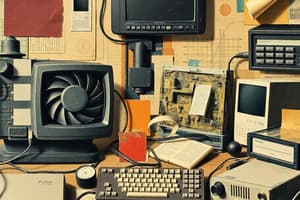Podcast
Questions and Answers
What is the main function of the arithmetic and logic unit (ALU)?
What is the main function of the arithmetic and logic unit (ALU)?
- Control the input/output devices
- Manage the flow of data between the CPU and memory
- Store data in storage devices
- Perform arithmetic and logical operations (correct)
Which functional unit in the processing unit is responsible for managing the data flow between the CPU and memory?
Which functional unit in the processing unit is responsible for managing the data flow between the CPU and memory?
- Arithmetic and Logic Unit (ALU)
- Control Unit (correct)
- Register
- None of the above
What type of operations does the Arithmetic and Logic Unit (ALU) perform?
What type of operations does the Arithmetic and Logic Unit (ALU) perform?
- Arithmetic and logical operations (correct)
- Input/output operations
- Data storage operations
- Memory retrieval operations
Which functional unit in the processing unit is responsible for executing instructions and making decisions based on data received from input devices?
Which functional unit in the processing unit is responsible for executing instructions and making decisions based on data received from input devices?
What are the main components of a processing unit?
What are the main components of a processing unit?
Which functional unit in the processing unit performs logical operations like AND, OR, and NOT?
Which functional unit in the processing unit performs logical operations like AND, OR, and NOT?
What is the role of the control unit in a processing unit?
What is the role of the control unit in a processing unit?
Which of the following is NOT a functional unit of the processing unit?
Which of the following is NOT a functional unit of the processing unit?
What type of operations does the control unit perform?
What type of operations does the control unit perform?
What is the main function of registers in a computer system?
What is the main function of registers in a computer system?
Which storage device is used to store data permanently or semi-permanently?
Which storage device is used to store data permanently or semi-permanently?
What is the role of an operating system in a computer system?
What is the role of an operating system in a computer system?
Which of the following is NOT a function performed by operating systems?
Which of the following is NOT a function performed by operating systems?
In a computer system, which component is responsible for providing common services for other applications?
In a computer system, which component is responsible for providing common services for other applications?
What is the primary purpose of application software in a computer system?
What is the primary purpose of application software in a computer system?
Which type of software directly interacts with users and enables them to perform tasks on a computer?
Which type of software directly interacts with users and enables them to perform tasks on a computer?
What kind of memory is essential for the CPU to access data quickly and efficiently?
What kind of memory is essential for the CPU to access data quickly and efficiently?
What type of software manages files and directories in a computer system?
What type of software manages files and directories in a computer system?
Flashcards are hidden until you start studying
Study Notes
Basic Structure of Computer Hardware and Software
Computer systems consist of both hardware and software components, each with its own unique structure and functionality. Understanding the basic structure of these components is crucial for developing efficient and effective computer systems. In this article, we will explore the three main parts of computer hardware: input/output devices, processing units, and storage devices, as well as the two main parts of computer software: operating systems and application software.
Input/Output Devices
Input/output devices, commonly referred to as I/O devices, are used to interact with the computer. They can be categorized into two types: input devices and output devices. Input devices include keyboards, mice, and scanners, while output devices include monitors, printers, and speakers.
Processing Units
Processing units, also known as central processing units (CPUs), perform arithmetic and logical operations. They are responsible for executing instructions and making decisions based on the data received from input devices. Processing units have several functional units, including the arithmetic and logic unit (ALU), control unit, and register.
Arithmetic and Logic Unit (ALU)
The arithmetic and logic unit (ALU) performs arithmetic operations such as addition, subtraction, and multiplication, as well as logical operations like AND, OR, and NOT.
Control Unit
The control unit manages the flow of data between the CPU and memory. It retrieves instructions from memory, decodes them, and sends the necessary data to the ALU for processing.
Registers
Registers are small, fast memory storage locations used to hold data temporarily. They are essential for the CPU to access data quickly and efficiently.
Storage Devices
Storage devices are used to store data and programs permanently or semi-permanently. They include hard drives, solid-state drives (SSDs), and flash memory.
Operating Systems
An operating system (OS) is a software program that manages the computer's resources and provides common services for other applications. It acts as an interface between the user and the computer hardware.
Functions of Operating Systems
Operating systems perform various functions such as managing system memory, controlling input/output devices, managing files and directories, running programs, maintaining security, and providing networking capabilities.
Application Software
Application software, also known as application programs or apps, are designed to perform specific tasks for users. These can range from productivity tools like word processors and spreadsheets to entertainment applications like games and media players.
In conclusion, understanding the basic structure of computer hardware and software is essential for anyone working with computers. By knowing how different components interact and function together, you can develop more efficient and effective computer systems.
Studying That Suits You
Use AI to generate personalized quizzes and flashcards to suit your learning preferences.




